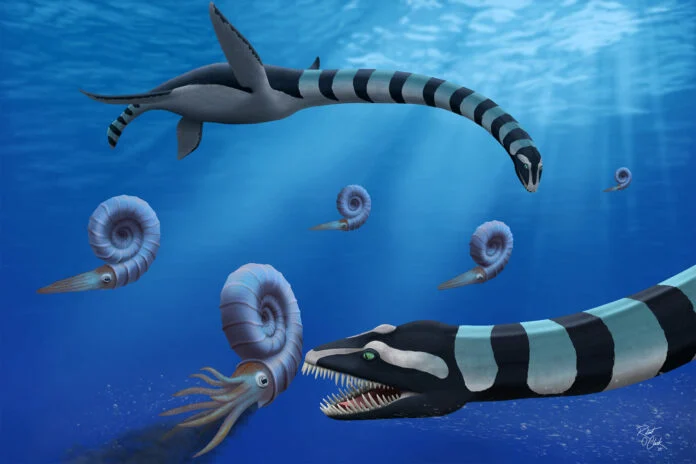A newly identified species of marine reptile has emerged from the depths of prehistory—thanks to a team of international paleontologists who recently published their findings in the Journal of Systematic Palaeontology. The fossils, discovered decades ago on a Canadian island, belong to a previously unknown species of elasmosaur, a fearsome predator that once dominated the Cretaceous seas.
Meet Traskasaura sandrae – A 12-Meter Marine Giant
Elasmosaurs were aquatic reptiles belonging to the larger group of plesiosaurs. These creatures swam the ancient oceans between 83.6 and 72.1 million years ago, and their most distinctive feature was an extraordinarily long neck—so long, in fact, that the neck and head combined made up half the total body length, which could reach up to 13 meters.
The newly discovered species, named Traskasaura sandrae, lived approximately 85 million years ago and measured around 12 meters in length. According to researchers, it stood out from other elasmosaurs thanks to its unique features and deadly adaptations.
A Predator Unlike Any Other
What sets Traskasaura sandrae apart is its large, razor-sharp set of teeth, designed to dispatch prey both swiftly and violently. Even more intriguing, the team suggests that this creature may have attacked its prey from above—a hunting strategy not previously associated with elasmosaurs or other plesiosaurs.
These behavioral traits mark Traskasaura sandrae as a particularly agile and aggressive predator, reshaping what we thought we knew about the feeding habits and ecological roles of these prehistoric sea reptiles.
A Fossil Mystery Decades in the Making
The fossils were originally discovered in 1988, in a river on Vancouver Island, but their identification remained elusive. The remains exhibited highly unusual anatomical traits that left experts puzzled for years, unable to place the specimen within any known family or species.
It wasn't until a collaborative team of paleontologists from Canada, Chile, and the United States applied modern analysis techniques that the mystery began to unravel. Through advanced fossil study and comparative anatomy, the team confirmed that the remains belonged to a completely new species of elasmosaur—one that had remained hidden in plain sight for nearly four decades.
A Glimpse into a Forgotten Ocean World
The discovery of Traskasaura sandrae not only adds a new member to the elasmosaur family tree but also enriches our understanding of prehistoric marine ecosystems. Each new species brings us closer to comprehending the diversity, evolution, and behaviors of Earth’s ancient oceanic predators.
In the ever-evolving field of paleontology, this find is a striking reminder: sometimes, the monsters of the deep are real—and they’ve been waiting millions of years to tell their story.






